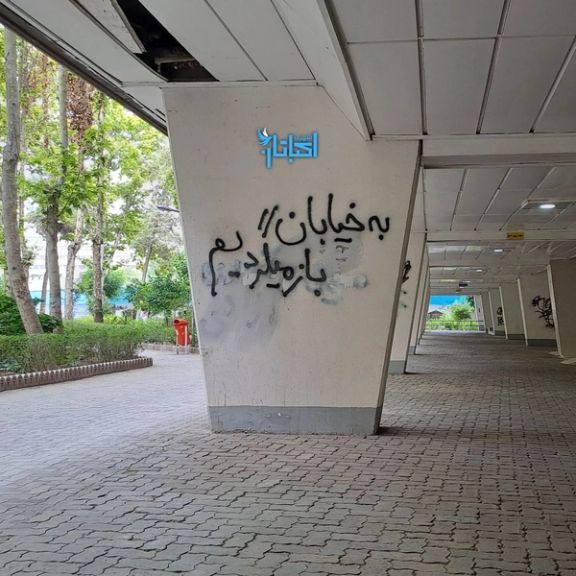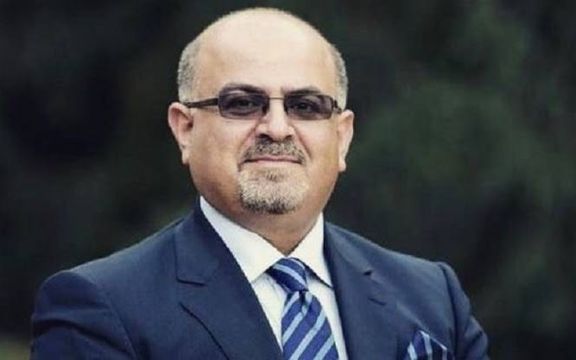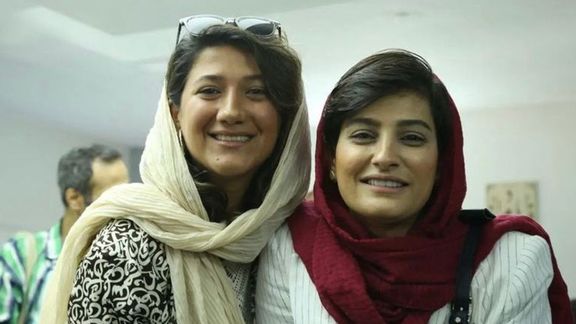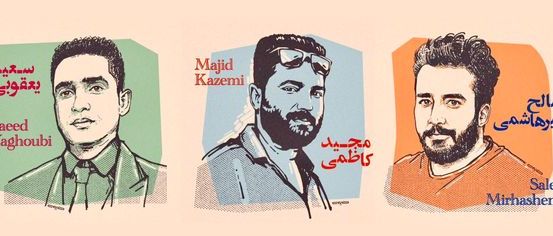Activist Hails Ukrainian Athlete Who Refused To Shake Hands With Iranian Participants

Iranian activist Masih Alinejad has expressed support for the Ukrainian athlete who refused to shake hands with an Iranian competitor.

Iranian activist Masih Alinejad has expressed support for the Ukrainian athlete who refused to shake hands with an Iranian competitor.
At the World Bench Press Championships in South Africa on Tuesday, Ukrainian powerlifter Ivan Chuprynko refused to shake hands with the Iranian athlete, Amir Reza Mesforoush, in an apparent statement against Iran's arming Russia in its invasion of Ukraine.
"I fully defend the move by the Ukrainian athlete," said Alinejad in a tweet adding that "the athletes who decide to compete under the flag of Iran represent the Islamic Republic."
During the award ceremony, Chuprynko shook hands with the South African athlete and did not even turn towards Iranian Amir Reza Mesforoush. Ivan declined to shake hands with the Iranian representative twice, and Mesforoush shrugged his shoulders in response.
The condemnation puts Iran's athletes in a difficult predicament. Many have spoken out against the regime oppression, but continue to compete and represent the Iranian people.
After the World Cup rebellion in which players refused to sing the anthem, several of the country's football team were given punishments including flight bans and pay cuts.
One of the country's leading chess players competed on the world stage without her headscarf and was subsequently unable to return home.
Several countries such as the US and European Union have sanctioned Iran for its provision of drones in Russia’s war on Ukraine.
Iran has denied sending drones to Russia for months, but with increasing evidence, Foreign Minister Hossein Amir Abdollahian finally admitted the issue in November last year. However, he claimed that the deployment of drones was "limited and before the war in Ukraine".

Despite severe repressions, the protests against the clerical regime continued Wednesday night.
People in several districts of Tehran held gatherings after Persepolis soccer club won the Hazfi cup.
In the restive Ekbatan neighborhood west of Tehran, protesters chanted slogans against Supreme Leader Ali Khamenei saying, “So Many Years of Crime, Death to the Leader”.
Another video shows people urging the release of imprisoned rapper Toomaj Salehi during the Wednesday night protests.
Earlier in the day, and during the final match of Hazfi cup between two popular soccer clubs of Tehran, fans shouted the name of two dissident players Ali Karimi and Voria Ghafouri.
Voria Ghafouri, the popular former captain of Iran's top football club Esteghlal, had earlier announced he is going to end his professional career on Wednesday during the derby match between Esteghlal and Persepolis.
However, the security agents reportedly did not let the popular footballer enter the stadium in fear of anti-regime protests and slogans.
The football star who was fired from his team for criticizing the government, decided to retire very soon but not to give in to the regime’s demands. His early retirement drew reactions from opposition figures including Masih Alinejad who praised his decision.
Amid the extreme suppression of protesters, Iranians take every single opportunity to express anger at the Islamic Republic and its brutalities.

An Iranian lawyer says the Iranian Revolutionary Court is not qualified to investigate the charges of two imprisoned journalists who covered the death of Mahsa Amini.
“According to the constitution, the branches of the Revolutionary Court do not have the jurisdiction to deal with political and journalistic cases,” said Arash Keikhosravi.
He said that according to law, Elahe Mohammadi and Niloufar Hamedi should have been released by now and their case should have been referred to one of the branches of the Criminal Court.
Their case has to be investigated in the presence of a jury in an open court, so that justice can be served, he added after the first hearing was held Monday in Tehran behind closed doors.
The two journalists have been charged with propaganda against the regime and conspiracy to commit acts against national security, which could bear death sentences.
Hamedi managed to visit Mahsa Amini in Tehran’s Kasra hospital and broke the news of her grave condition after being taken into the custody of the morality police three days earlier for wearing her hijab “improperly”. Amini was in a coma at the time.
Mohammadi, likewise, managed to travel to Amini’s hometown of Saqqez in western Iran to report on her funeral on September 17, which thousands attended.
The US State Department has called the "sham" trial a "mockery of justice" and shows the Islamic Republic's fear of journalists.

Reporters Without Borders (RSF) condemned the trials of Niloofar Hamedi and Elahe Mohammadi who first reported the death in custody of Mahsa Amini in September.
Calling the trials “sham” in a statement Tuesday, RSF said the two journalists who have been in detention since a few days after Amini’s death should be freed at once instead of facing possible death sentences.
The two journalists have been charged with propaganda against the regime and conspiracy to commit acts against national security, which could bear death sentences.
“The fact that Niloofar Hamedi and Elaheh Mohammadi were unable to see their lawyers, even a few days before their trials, confirms that this is travesty of justice whose sole aim is to legitimise the persecution of these two journalists. We demand their immediate release,” Jonathan Dagher, head of RSF’s Middle East desk, said.
In a tweet Tuesday, RSF also said banning the lawyers of the two journalists from speaking at their hearings was “further proof of the judicial farce against the two journalists.”
Hamedi, managed to visit Mahsa Amini in Tehran’s Kasra hospital and broke the news of her grave condition after being taken into the custody of the morality police three days earlier for wearing her hijab “improperly”. Amini was in a coma at the time.
Mohammadi, likewise, managed to travel to Amini’s hometown of Saqqez in western Iran to report on her funeral, September 17, which thousands attended.
The lawyers for Niloofar Hamedi, a reporter of the reformist Shargh daily, and Elahe Mohammadi, of the reformist Ham-Mihan newspaper, were banned from speaking at the 1st hearings.,” RSF tweeted Tuesday.

The first session of Mohammadi’s trial presided by the notorious judge Abolghasem Salavati was held behind closed doors at Branch 15 of the Revolutionary Court of Tehran on Monday. Hamedi’s hearing was held on Tuesday by the same judge and in the same manner. Lawyers of the two journalists were not allowed to speak.
Hamedi’s husband, Mohammad-Hossein Ajorlou who is a sports journalist himself, in a series of tweets Tuesday confirmed that Hamedi’s lawyer had not been given an opportunity to speak and said family members, including himself, were not allowed in the courtroom. According to Ajorlou’s tweet the date for the next hearing has not been set.
The Telegram channel of the ultrahardliner Raja News claimed that “anti-Iranian media” are trying to “reduce” the arrest of the two journalists to their coverage of Mahsa Amini’s death.
“But reliable information indicates that Niloofar Hamedi and Elaheh Mohammadi had participated in training courses of institutions that seek the overthrow [of the Islamic Republic] and had connections with foreign intelligence services,” Raja News which is affiliated to the ultraconservative Paydari Front wrote.
In October, Iran's intelligence ministry and SAS, the intelligence organization of the Revolutionary Guards (IRGC) accused Mohammadi and Hamedi of being CIA agents. “Using the cover of a journalist, she was one of the first people who arrived at the hospital and provoked the relatives of the deceased and published targeted news,” they said in a joint statement.

Abbas Abdi, a reform bloke politician said in a May 23 tweet that the government twists charges against dissidents to avoid open trials and demanded that the two journalists be tried publicly according to article 165 of the Iranian Constitution.
The Iranian Constitution stipulates that trials of political prisoners and journalists should be public and with the presence of a jury.

Amid global outrage over Iran's execution machine, the regime’s chief justice has defended the hanging of protesters, vowing to continue its killing spree.
Islamic Republic Judiciary Chief Gholamhossein Mohseni Ejei said Tuesday "The [death] sentences of those [protesters] who were/are supposed to be executed for their crimes during the riots have either been or will be carried out without any consideration while ensuring full observance of legal procedures, justice and fairness."
Emphasizing that the sentences will be implemented “without any delay,” he also defiantly called on security and intelligence agencies to arrest women who are flouting mandatory hijab rules and to hand them over to the judicial authorities for “severe punishment.”
Accusing protesters and those unveiling in public of being connected to “the enemies,” Ejei emphatically vowed: “Be sure that these elements will be severely punished.”
In the Islamic Republic's jargon "enemy" is used to refer primarily to the United States and Israel, and sometimes to their allies, and recently every entity and individual who has expressed support for the current wave of anti regime protests.
“The enemies are trying to create a divide in our society by psychological operations and bombarding the minds of young people and by taking advantage of some existing weaknesses,” the chief justice said, claiming these 'enemies' are trying to divide Iranian society.
Since the early weeks of the nationwide protests ignited by the death of 22-year-old Mahsa Amini by hijab or ‘morality’ police in September, the staunch regime mouthpiece has repeatedly ordered judges to issue tough sentences to protesters and those flouting regime diktat.
"I have instructed our judges to avoid showing unnecessary sympathy to main elements of these riots and issue tough sentences for them while separating the less guilty people," he said in October. In April, he warned of strict punishment for women flouting hijab rules.
Following the death of Amini for "improper hijab," a growing number of women have been ditching their veils in public, risking arrest by defying hijab laws in public places such as streets, malls, shops, banks, cafes, and even airports with videos and photos surfacing online everyday describing scenes with women casting off their headscarves as the new normal in Iran.
The Islamic Republic has intensified its killing trend in recent weeks, fueling further protests across the country. At least 259 Iranians have been executed since January alone, according to the United Nations.

Amid a spike in executions since late April, on May 19, authorities arbitrarily executed three tortured protesters, Majid Kazemi, Saeed Yaghoubi and Saleh Mirhashemi who were unjustly convicted and sentenced to death in Isfahan (Esfahan).
The deaths brought to at least seven the number of protesters hanged since nationwide protests broke out in September 2022 following the death in custody of 22-year-old Mahsa Amini. The unrest posed the biggest internal challenge to the Islamic Republic since its establishment in 1979.
Earlier in March, Amnesty International said at least seven individuals in Iran face the death sentence in connection with protests, while dozens of others are at risk of being sentenced to death.
So far, around 750 civilians have been killed by security forces and at least 30,000 arrested. While many have been released, around 1,500 face criminal charges, and at least 80 detainees face the death sentence for the “moharebeh” and “corruption on earth”, Islamic-Arabic terms meaning to go against the will of God. Both carries the death penalty.

Iran’s Minister of Interior has rebuffed the UN fact finding mission on Iran calling it a media war against the regime.
Speaking at an ambassadorial meeting, Ahmad Vahidi said: “The enemy has created an unrealistic image of Iran in the minds of people in all parts of the world using its mainstream media.”
In spite of the deaths of around 750 civilians and arrest of 30,000 more, he claimed that in protests following the death in morality police custody of Mahsa Amini, the police and security forces 'exercised restraint', blatantly denying the brutal crackdowns which have been wrought across the country.
The Human Rights Council decided to establish an independent international fact-finding mission on Iran's deadly repression of protests in October, after unrest broke out in September.
The UN mission in particular asked for information concerning violent crackdown on peaceful protests by security forces, including alleged arbitrary arrests and detentions, sexual and gender-based violence, excessive use of force, torture and other inhumane treatment and enforced disappearances, as well as the deaths of hundreds of peaceful protesters and thousands of arrests.
The mission is also seeking documentation on physical, psychological and sexual abuse of women and girls for exercising their human rights and fundamental freedoms, and children’s rights violations in relation to the protests, including in raids on schools, and the incarceration of children in ‘psychological centers.'